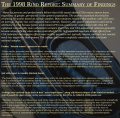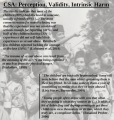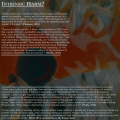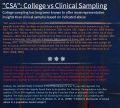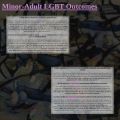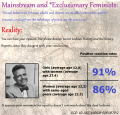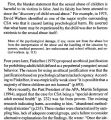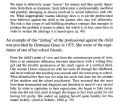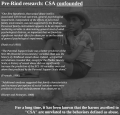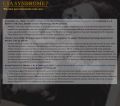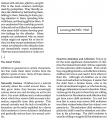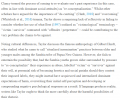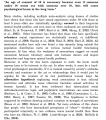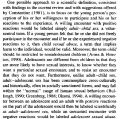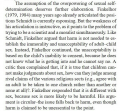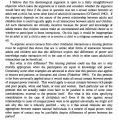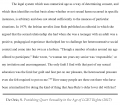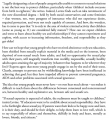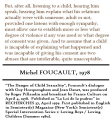One of our staff members is contributing considerably to a News Archiving service at Mu. Any well educated (Masters, PhD or above) users who wish to make comments on news sites, please contact Jim Burton directly rather than using this list, and we can work on maximising view count.
Research: Prevalence of Harm and Negative Outcomes: Difference between revisions
The Admins (talk | contribs) |
The Admins (talk | contribs) No edit summary |
||
| Line 20: | Line 20: | ||
*'''[[Bruce Rind|Rind, B.]] (2021). [https://pubmed.ncbi.nlm.nih.gov/32430871/ "First Sexual Intercourse in the Irish Study of Sexual Health and Relationships: Current Functioning in Relation to Age at Time of Experience and Partner Age,"] ''Archives of Sexual Behavior'', 50(1):289-310.''' | *'''[[Bruce Rind|Rind, B.]] (2021). [https://pubmed.ncbi.nlm.nih.gov/32430871/ "First Sexual Intercourse in the Irish Study of Sexual Health and Relationships: Current Functioning in Relation to Age at Time of Experience and Partner Age,"] ''Archives of Sexual Behavior'', 50(1):289-310.''' | ||
*:"The vast majority of cases involved postpubertal heterosexual coitus. Overall, minors involved with adults were not significantly less well adjusted than adults involved with other adults on a majority of measures, effect size differences in adjustment were mostly small, and mean adjustment responses consistently indicated good rather than poor adjustment." | *:"The vast majority of cases involved postpubertal heterosexual coitus. Overall, minors involved with adults were not significantly less well adjusted than adults involved with other adults on a majority of measures, effect size differences in adjustment were mostly small, and mean adjustment responses consistently indicated good rather than poor adjustment." | ||
*'''[[Bruce Rind|Rind, B.]] (2022). [https://link.springer.com/article/10.1007/s10508-021-02224-0 "Reactions to Minor-Older and Minor-Peer Sex as a Function of Personal and Situational Variables in a Finnish Nationally Representative Student Sample",] ''Archives of Sexual Behavior'', 2022.''' | |||
*:"Felson et al. (2019) used a large-scale nationally representative Finnish sample of sixth and ninth graders to estimate the population prevalence of negative subjective reactions to sexual experiences between minors under age 18 and persons at least 5 years older and between minors and peer-aged partners for comparison. They then accounted for these reactions in multivariate analysis based on contextual factors. The present study argued that focusing exclusively on negative reactions short-changed a fuller scientific understanding. It analyzed the full range of reactions in the same sample, focusing on positive reactions. For reactions in retrospect, boys frequently reacted positively to minor-older sex (68%, n = 280 cases), on par with positive reactions to boy-peer sex (67%, n = 1510). Girls reacted positively to minor-older sex less often (36%, n = 1047) and to girl-peer sex half the time (48%, n = 1931). In both minor-older and minor-peer sex, rates of positive reactions were higher for boys vs. girls, adolescents vs. children, when partners were friends vs. strangers or relatives, with intercourse vs. lesser forms of sexual intimacy, with more frequent sex, and when not coerced. Boys reacted positively more often with female than male partners. In minor-older sex, partner age difference mattered for girls but not boys, and the minor’s initiating the sex (14% for girls, 46% for boys) produced equally high rates of positive reactions. Most of these factors remained significant in multivariate analysis. The frequency of positive reactions, their responsiveness to context, the similarity in reaction patterns with minor-peer sex, and the generalizability of the sample were argued to contradict the trauma view often applied to minor-older sex, holding it to be intrinsically aversive irrespective of context." | |||
*'''Larsen, K. & Larsen, H. (2007). "[https://pubmed.ncbi.nlm.nih.gov/16982501/ The prevalence of unwanted and unlawful sexual experiences reported by Danish adolescents: Results from a national youth survey in 2002]," ''Acta Paediatrica'', 2006 Oct;95(10):1270-6.''' | *'''Larsen, K. & Larsen, H. (2007). "[https://pubmed.ncbi.nlm.nih.gov/16982501/ The prevalence of unwanted and unlawful sexual experiences reported by Danish adolescents: Results from a national youth survey in 2002]," ''Acta Paediatrica'', 2006 Oct;95(10):1270-6.''' | ||
Revision as of 01:35, 12 January 2022
 | ||||||||||||
| Part of NewgonWiki's research project | ||||||||||||
|---|---|---|---|---|---|---|---|---|---|---|---|---|
|
| ||||||||||||
| ||||||||||||
|
| ||||||||||||
| Template: Research - This template |
Research (much of it outdated) investigating CSA as a clinical/legal/traumatic phenomenon, using similarly obtained samples is wrongly generalized by practitioners and educators to the entire population. This article pools mainly nonclinical, nonlegal and nontraumatic sampled research articles documenting the prevalence of harm. Rind et al (1998) confirmed that CSA is not a reliable predictor of later maladjustment, when other factors are accounted for. Self-perception of (simple) consent is also a strong predictor of indifferent or positive outcomes. These results have been re-affirmed as recently as 2021 by Daly.
As a side note, prevalence of CSA is widely held to be "1 in 10" for the purpose of clarity in victim advocacy, but varies by gender and depending on definition of abuse (peer vs adults only, etc). None of these are settled debates.[1]
Outcomes
- Rind, Bruce; Tromovitch, Philip; Bauserman, Robert (1998). "A Meta-Analytic Examination of Assumed Properties of Child Sexual Abuse Using College Samples," Psychological Bulletin, 124(1), 22-53
- "Many lay persons and professionals believe that child sexual abuse (CSA) causes intense harm, regardless of gender, pervasively in the general population. The authors examined this belief by reviewing 59 studies based on college samples. Meta-analyses revealed that students with CSA were, on average, slightly less well adjusted than controls. However, this poorer adjustment could not be attributed to CSA because family environment (FE) was consistently confounded with CSA, FE explained considerably more adjustment variance than CSA, and CSA-adjustment relations generally became nonsignificant when studies controlled for FE. Self-reported reactions to and effects from CSA indicated that negative effects were neither pervasive nor typically intense, and that men reacted much less negatively than women. The college data were completely consistent with data from national samples. [...]
- Fifteen studies presented data on participants' retrospectively recalled immediate reactions to their CSA experiences that were classifiable as positive, neutral, or negative. Overall, 72% of female experiences, but only 33% of male experiences, were reported to have been negative at the time. On the other hand, 37% of male experiences, but only 11% of female experiences, were reported as positive. [...] Seven female and three male samples contained reports of positive, neutral, and negative current reflections (i.e., current feelings) about CSA experiences. Results were similar to retrospectively recalled immediate reactions, with 59% of 514 female experiences being reported as negative compared with 26% of 118 male experiences. Conversely, 42% of current reflections of male experiences, but only 16% of female experiences, were reported as positive. [...] The overall picture that emerges from these self-reports is that (a) the vast majority of both men and women reported no negative sexual effects from their CSA experiences; (b) lasting general negative effects were uncommon for men and somewhat more common for women, although still comprising only a minority; and (c) temporary negative effects were more common, reported by a minority of men and a minority to a majority of women."
- Daly, N. R. (2021). Relationship of Child Sexual Abuse Survivor Self-Perception of Consent to Current Functioning, PhD thesis.
- "In 1998 Rind, Tromovitch and Bauserman conducted a meta-analysis using a college sample which challenged the prevailing belief that childhood sexual abuse (CSA) has inherent deleterious effects. Resultantly, the authors proposed alternative terminology (e.g., child-adult sex), without adequate investigation into what distinguishes child-adult sex from CSA. In response, the current study investigated the relationship between CSA, consent and adult functioning in a college sample [...] These results suggest that based on CSA status, a college sample does not exhibit significant deficits in psychological functioning or family environment and may not be comparable to samples of CSA survivors in the general population."
- Lahtinen, H., et al., (2018). "Children's disclosures of sexual abuse in a population-based sample," Child abuse and Neglect, Feb 2018; 76: 84-94.
- NewgonWiki: 2.4% of the sample (12 and 15 year olds) reported CSA experiences, of which the majority found them to be positive. For the boys, the experience was often positive (71%) vs (9% negative), whereas for the girls it was less often so evaluated (26%) vs (46%) negative. The most popular reason for not disclosing the contact to an adult was considering the experience not serious enough (41%). Despite a CSA sample of 256, the authors bizarrely refused to test for statistical significance of trends.
- "The small number of answers to the question of whether a sexual incident with an adult was considered negative or positive does not enable testing statistical significance [...] Most of the children reported these incidents as positive. This highlights the potentially contradictory views of an incident from the perspective of the respondent compared to that of society and the law [...] These results, taken together with the finding that many of the children did not label their experiences as sexual abuse, indicate that more age-appropriate safety education for children and adolescents is needed to encourage disclosures to adults early enough [...] Early disclosure is crucial, both for ending the abuse and for preventing perpetrators from moving on to new victims."
- Rind, B. (2021). "First Sexual Intercourse in the Irish Study of Sexual Health and Relationships: Current Functioning in Relation to Age at Time of Experience and Partner Age," Archives of Sexual Behavior, 50(1):289-310.
- "The vast majority of cases involved postpubertal heterosexual coitus. Overall, minors involved with adults were not significantly less well adjusted than adults involved with other adults on a majority of measures, effect size differences in adjustment were mostly small, and mean adjustment responses consistently indicated good rather than poor adjustment."
- Rind, B. (2022). "Reactions to Minor-Older and Minor-Peer Sex as a Function of Personal and Situational Variables in a Finnish Nationally Representative Student Sample", Archives of Sexual Behavior, 2022.
- "Felson et al. (2019) used a large-scale nationally representative Finnish sample of sixth and ninth graders to estimate the population prevalence of negative subjective reactions to sexual experiences between minors under age 18 and persons at least 5 years older and between minors and peer-aged partners for comparison. They then accounted for these reactions in multivariate analysis based on contextual factors. The present study argued that focusing exclusively on negative reactions short-changed a fuller scientific understanding. It analyzed the full range of reactions in the same sample, focusing on positive reactions. For reactions in retrospect, boys frequently reacted positively to minor-older sex (68%, n = 280 cases), on par with positive reactions to boy-peer sex (67%, n = 1510). Girls reacted positively to minor-older sex less often (36%, n = 1047) and to girl-peer sex half the time (48%, n = 1931). In both minor-older and minor-peer sex, rates of positive reactions were higher for boys vs. girls, adolescents vs. children, when partners were friends vs. strangers or relatives, with intercourse vs. lesser forms of sexual intimacy, with more frequent sex, and when not coerced. Boys reacted positively more often with female than male partners. In minor-older sex, partner age difference mattered for girls but not boys, and the minor’s initiating the sex (14% for girls, 46% for boys) produced equally high rates of positive reactions. Most of these factors remained significant in multivariate analysis. The frequency of positive reactions, their responsiveness to context, the similarity in reaction patterns with minor-peer sex, and the generalizability of the sample were argued to contradict the trauma view often applied to minor-older sex, holding it to be intrinsically aversive irrespective of context."
- Larsen, K. & Larsen, H. (2007). "The prevalence of unwanted and unlawful sexual experiences reported by Danish adolescents: Results from a national youth survey in 2002," Acta Paediatrica, 2006 Oct;95(10):1270-6.
- NewgonWiki: The youth were all aged 15. Specific data in tables revealed that 7.5% of girls and 2% of boys reported encounters with a 5+ year age gap or more - 59 and 65% respectively felt they had not been abused.
- "Multimedia computer-based self-administered questionnaires (CASI) were completed by a national representative sample of 15–16-y-olds. Child sexual abuse was defined according to the penal code and measured by questions defining specific sexual activities, the relationship between the older person and the child, and the youth's own perception of the incident. Results: Among 5829 respondents, 11% reported unlawful sexual experiences, 7% of boys and 16% of girls. Only 1% of boys and 4% of girls felt that they “definitely” or “maybe” had been sexually abused. Conclusion: A relatively high percentage of Danish adolescents have early, unlawful sexual experiences. However, young people's own perception of sexual abuse tends to differ from that of the authorities, or their tolerance of abusive incidents is high. Gender differences were found in factors predicting perception of abuse."
- Oellerich, T.D. (1998). "Identifying and Dealing with 'Child Savers'", IPT Journal.
- "Kilpatrick (1992) concluded that early child and adolescent sexual experiences, unless there was force or high pressure involved, had no influence on later adult functioning regardless of the type of partner involved (i.e., relative or non-relative) or the age differences. She reported that, when she discussed her findings with professionals, they closed their ears to them. They were most closed to those findings that indicated positive reactions to these early sexual experiences and to those findings that indicated that incestuous experiences did not cause irreparable harm."
- Rind, Bruce (1995). "An Analysis of Human Sexuality Textbook Coverage of the Psychological Correlates of Adult - Nonadult Sex", Journal of Sex Research, 32(3), p. 219-233
- "First, researchers using college samples who have investigated consequences of adult-nonadult sex have generally found either no effects on psychological adjustment attributable to this experience (e.g., Cole, 1987; Fromuth, 1986; Harter, Alexander, & Neimeyer, 1988; Hatfield, 1987; Higgins & McCabe, 1994; Hrabowy & Allgeier, 1987; Pallotta, 1991; Predieri, 1991; Silliman, 1993; Zetzer, 1990), or only a few effects out of many measures--effects that have been small in terms of effect size (e.g., Alexander & Lupfer, 1987; Bergdahl, 1982; Edwards & Alexander, 1992; Fromuth & Burkhart, 1987; Haggard & Emery, 1989; Sarbo, 1984; White & Strange, 1993). Thus, college students who have experienced sex with adults when they were younger do not, as a group, exhibit the kind of maladjustment that has been frequently reported in clinical studies (for reviews of clinical studies, see, e.g., Beitchman, Zucker, Hood, DaCosta, & Akman, 1991; Beitchman et al., 1992)."
- Baurmann, Michael C. (1983). Sexuality, Violence and Psychological After-Effects: A Longitudinal Study of Cases of Sexual Assault which were Reported to the Police.
- "The victimological analysis was based on a 4-year questionnaire study (1969 - 1972) of virtually all sexual victims known to the police in the German state of Lower Saxony (n = 8058). [...] To recapitulate, only half of the declared victims (51.8%) of indecent assault suffered from injuries or even severe trauma. The other 48.2% had no problems in connection with the experience. In most of these cases the sexual offense was relatively superficial and harmless and/or the "victim" consented to the offense (page 459). [...] Homosexual contacts played no important statistical or criminological role in this study. On the one hand, they composed only 10-15% of the cases, and on the other, the sexual contacts were described by the victims themselves as "harmless", almost exclusively without the use of violence by the suspect (page 287), and as a result, none of the male victims questioned felt themselves to have been injured. In addition no injury could be determined in these cases with the help of test procedures."
- Steever, E. E., Follette, V. M., & Naugle, A. E. (2001). "The correlates of male adults' perceptions of their early sexual experiences," Journal of Traumatic Stress, 14(1), 189–204.
- "Three groups of participants were assessed for this study: (1) men who report no history of childhood sexual experiences or report a history of consensual childhood and adolescent sexual experiences with peers (less than five years age difference; NSA), (2) men who do not identify themselves as survivors of childhood sexual abuse, but report a history of childhood or adolescent (before age eighteen) sexual experiences that were coercive/forced in nature, occurred with an individual at least 5 years older than the subject, or were incestuous in nature (involved an older family member), thus satisfying typical research definitions of child sexual abuse (ESE), and (3) men who report a history of childhood sexual experiences that they label as sexual abuse (CSA). [...] Analysis of variance between groups revealed that Group CSA (M = .71, SD = .42) reported significantly more distress than Group NSA (M = .40, SD = .36) or Group ESE did (M = .46, SD = .22). [...] Consistent with our hypotheses, participants in Group CSA were twice as likely to have participated in psychotherapy as participants in Group ESE. In fact, more than half of Group CSA reported that they had sought mental health treatment. [...] Participants in Group ESE, who by standard research criteria would be classified as "abused" did not seek out mental health counseling to a statistically greater degree than participants in Group NSA. Because the participants in Group ESE did not report higher levels of psychological distress than those in Group NSA, it seems likely that these men did not seek treatment because of lack of distress."
- Finkelhor, David (1990). "Early and long-term effects of child sexual abuse: An update," Professional Psychology: Research and Practice, 21(5), pp. 325-330.
- Using mostly clinical samples: "Almost every study of the impact of sexual abuse has found a substantial group of victims with little or no symptomatology. Runyon (personal communication, September 23, 1988) found one quarter to one third of the victims without symptoms on the study's major clinician-rated measure of trauma. Mannarino and Cohen (1986) found 31% to be symptom-free. Tong et al. (1987) noted 36% of the children within the normal range on the Child Behavior Checklist. Conte and Schuerman (1987), using an extensive list of symptoms that included such minor items as “fearful of abuse stimuli” or such global items as “emotional upset,” found that 21% of abused children had no symptoms whatsoever (see also Sirles, Smith, & Kusama, 1989). [...] Research shows that such asymptomatic children are more likely to have been abused for a shorter period of time, without force and violence or penetration, by someone who is not a father figure and to have gotten support from parents in the context of a relatively well-functioning family (Browne & Finkelhor, 1986)."
- Rind, Bruce & Tromovitch, Philip (1997). "A meta-analytic review of findings from national samples on psychological correlates of child sexual abuse," Journal of Sex Research, 34, 237-255.
- "The self-reported effects data contradict the conclusions or implications presented in previous literature reviews that harmful effects stemming from CSA are pervasive and intense in the population of persons with this experience. Baker and Duncan (1985) found that, although some respondents reported permanent harm stemming from their CSA experiences (4% of males and 13% of females), the overwhelming majority did not (96% of males and 87% of females). Severe or intense harm would be expected to linger into adulthood, but this did not occur for most respondents in this national sample, according to their self-reports, contradicting the conclusion or implication of intense harm stemming from CSA in the typical case. Meta-analyses of CSA-adjustment relations from the five national studies that reported results of adjustment measures revealed a consistent pattern: SA respondents were less well adjusted than control respondents. Importantly, however, the size of this difference (i.e., effect size) was consistently small in the case of both males and females. The unbiased effect size estimate for males and females combined was ru = .08, which indicates that CSA, assuming that it was responsible for the adjustment difference between SA and control respondents, did not produce intense problems on average."
LGBT Outcomes
Gay/Trans people have recalled positive experiences in surveys addressing early sexual encounters with an adult. This is of strategic relevance, particularly to trans people who are attacked by Trans-Exclusionary Radical Feminists and the Alternative Right for supposedly seeking to "normalize" adult-minor relations. If such claims are being made by some gay and trans activists, the personal experiences of their own people can be said to back them up.
- Rind, B. (2016). "Reactions to First Postpubertal Female Same-Sex Sexual Experience in the Kinsey Sample: A Comparison of Minors with Peers, Minors with Adults, and Adults with Adults," Archives of Sexual Behavior, 46(5):1517-1528.
- "Data were collected by Kinsey interviewers between 1939 and 1961 (M year = 1947). Girls under 18 (M age = 14.9), whose sexual experience was with a woman (M age = 26.3), reacted positively just as often as girls under 18 (M age = 14.1) with peers (M age = 15.0) and women (M age = 22.7) with women (M age = 26.3). The positive-reaction rates were, respectively, 85, 82, and 79 %. In a finer-graded analysis, younger adolescent girls (≤14) (M age = 12.8) with women (M age = 27.4) had a high positive-reaction rate (91 %), a rate reached by no other group. For women (M age = 22.2) with same-aged peers (M age = 22.3), this rate was 86 %."
- Rind, B. (2016). "Reactions to First Postpubertal Male Same-Sex Sexual Experience in the Kinsey Sample: A Comparison of Minors With Peers, Minors With Adults, and Adults With Adults," Archives of Sexual Behavior, 45(7):1771-1786.
- "Rind and Welter (2014) examined first postpubertal coitus using the Kinsey sample, finding that reactions were just as positive, and no more negative, among minors with adults compared to minors with peers and adults with adults. In the present study, we examined first postpubertal male same-sex sexual experiences in the Kinsey same-sex sample (i.e., participants mostly with extensive postpubertal same-sex behavior), comparing reactions across the same age categories. These data were collected between 1938 and 1961 (M year: 1946). Minors under age 18 years with adults (M ages: 14.0 and 30.5, respectively) reacted positively (i.e., enjoyed the experience "much") often (70 %) and emotionally negatively (e.g., fear, disgust, shame, regret) infrequently (16 %). These rates were the same as adults with adults (M ages: 21.2 and 25.9, respectively): 68 and 16 %, respectively. Minors with peers (M ages: 13.3 and 13.8, respectively) reacted positively significantly more often (82 %) and negatively nominally less often (9 %). Minors with adults reacted positively to intercourse (oral, anal) just as often (69 %) as to outercourse (body contact, masturbation, femoral) (72 %) and reacted emotionally negatively significantly less often (9 vs. 25 %, respectively). For younger minors (≤14) with adults aged 5-19 years older, reactions were just as positive (83 %) as for minors with peers within 1 year of age (84 %) and no more emotionally negative (11 vs. 7 %, respectively). Results are discussed in relation to findings regarding first coitus in the Kinsey sample and to the cultural context particular to Kinsey's time."
- Dolezal, C. et al (2014). "Childhood sexual experiences with an older partner among men who have sex with men in Buenos Aires, Argentina," Child Abuse & Neglect, Volume 38, Issue 2, Pages 271-279.
- "NewgonWiki: Eighteen percent of the respondents reported sex before 13 with an age-gap partner, the majority of whom did not feel they were hurt by the experience and did not consider it to be childhood sexual abuse (CSA). Over two-thirds of reporters said that their older partner was a female. Only 4% of those with a female partner felt their experience was CSA compared to 44% of those who had a male partner."
- Carballo-Diéguez, A. et al (2012). "Recalled sexual experiences in childhood with older partners: a study of Brazilian men who have sex with men and male-to-female transgender persons," Archives of Sexual Behavior, 41(2):363-76.
- "For data analysis, raw scores were weighted based on participants' reported network size. Of 575 participants (85% men and 15% transgender), 32% reported childhood sexual experiences with an older partner. Mean age at first experience was 9 years, partners being, on average, 19 years old, and mostly men. Most frequent behaviors were partners exposing their genitals, mutual fondling, child masturbating partner, child performing oral sex on partner, and child being anally penetrated. Only 29% of the participants who had had such childhood sexual experiences considered it abuse; 57% reported liking, 29% being indifferent and only 14% not liking the sexual experience at the time it happened. Transgender participants were significantly more likely to report such experiences and, compared with men, had less negative feelings about the experience at the time of the interview. No significant associations were found between sexual experiences in childhood and unprotected receptive or insertive anal intercourse in adulthood."
- Arreola, Sonya; Neilands, Torsten; Pollack, Lance; Paul, Jay; Catania, Joseph (2008). "Childhood Sexual Experiences and Adult Health Sequelae Among Gay and Bisexual Men: Defining Childhood Sexual Abuse," Journal of Sex Research, 45(3), pp. 246 - 252.
- "Childhood sexual experience [minor-minor and adult-minor was included in this definition] was composed of three categories: None (no sex before age 18); consensual only (sex before age 18 that was NOT considered by the respondent to have been forced); and forced (having been "forced or frightened by someone into doing something sexually" at least once before age 18). [...] Interestingly, the forced sex group and the no sex group were statistically indistinguishable in their level of well-being, while the consensual sex group was significantly more likely to have a higher level of well-being than either of the other two groups. This suggests that consensual sex before 18 years of age may have a positive effect, perhaps as an adaptive milestone of adolescent sexual development. The emphasis in these data on pathology does not permit further exploration of this possibility. [...] There were no differences in rates of depression and suicidal ideation between the consensual- and no-sex groups. The consensual- and forced-sex groups had higher rates of substance use and transmission risk than the no-sex group. The forced-sex group, however, had significantly higher rates of frequent drug use and high-risk sex than the consensual group. Findings suggest that forced CSEs result in a higher-risk profile than consensual or no childhood sexual experiences, the kind of risk pattern differs between forced and consensual childhood sexual experiences, and the underlying mechanisms that maintain risk patterns may vary. It is important to clarify risk patterns and mechanisms that maintain them differentially for forced and consensual sex groups so that interventions may be tailored to the specific trajectories related to each experience."
- Rind, Bruce (2001). "Gay and Bisexual Adolescent Boys' Sexual Experiences With Men: An Empirical Examination of Psychological Correlates in a Nonclinical Sample", Archives of Sexual Behavior, 30(4), 345-368
- "Over the last quarter century the incest model, with its image of helpless victims exploited and traumatized by powerful perpetrators, has come to dominate perceptions of virtually all forms of adult-minor sex. Thus, even willing sexual relations between gay or bisexual adolescent boys and adult men, which differ from father-daughter incest in many important ways, are generally seen by the lay public and professionals as traumatizing and psychologically injurious. This study assessed this common perception by examining a nonclinical, mostly college sample of gay and bisexual men. Of the 129 men in the study, 26 were identified as having had age-discrepant sexual relations (ADSRs) as adolescents between 12 and 17 years of age with adult males. Men with ADSR experiences were as well adjusted as controls in terms of self-esteem and having achieved a positive sexual identity. Reactions to the ADSRs were predominantly positive, and most ADSRs were willingly engaged in. Younger adolescents were just as willing and reacted at least as positively as older adolescents. Data on sexual identity development indicated that ADSRs played no role in creating same-sex sexual interests, contrary to the "seduction" hypothesis. Findings were inconsistent with the incest model. The incest model has come to act as a procrustean bed, narrowly dictating how adult-minor sexual relations quite different from incest are perceived."
- Stanley, Jessica L., Bartholomew, Kim, and Oram, Doug (2004). "Gay and Bisexual Men's Age-Discrepant Childhood Sexual Experiences", The Journal of Sex Research, 41(4), pp. 381-389
- "This study examined childhood sexual abuse (CSA) in gay and bisexual men. We compared the conventional definition of CSA based on age difference with a modified definition of CSA based on perception to evaluate which definition best accounted for problems in adjustment. The sample consisted of 192 gay and bisexual men recruited from a randomly selected community sample. Men's descriptions of their CSA experiences were coded from taped interviews. Fifty men (26%) reported sexual experiences before age 17 with someone at least 5 years older, constituting CSA according to the age-based definition. Of these men, 24 (49%) perceived their sexual experiences as negative, coercive, and/or abusive and thus were categorized as perception-based CSA. Participants with perception-based CSA experiences reported higher levels of maladjustment than non-CSA participants. Participants with age-based CSA experiences who perceived their sexual experience as non-negative, noncoercive, and nonabusive were similar to non-CSA participants in their levels of adjustment. These findings suggest that a perception-based CSA definition more accurately represents harmful CSA experiences in gay and bisexual men than the conventional age-based definition. [...] no differences in adjustment were found between participants with CSE histories and participants who did not report an age-based CSA experience. Additionally, the perception-based definition predicted maladjustment in four areas of interpersonal difficulties over and above that predicted by the age-based criterion. [...] empirical evidence indicates that age-discrepant childhood sexual experiences are not necessarily harmful (e.g., Constantine, 1981; Rind et al., 1998; Steever et al., 2001). Therefore, it must be acknowledged that a violation of social norms, which is the basis for the age-based definition, does not necessarily result in harm. A definition of CSA based on social norm violations is further problematic for same-sex relations because same-sex sexual activity is considered a social norm violation by many. Some in the gay community believe that some sexual experiences involving mature adolescents and older partners may be beneficial (e.g., Sandfort, 1983; Savin-Williams, 1998). Several arguments can be made supporting this position. These sexual experiences may provide these adolescents with the opportunity to explore their sexuality and feel affirmed by the gay community. Gay youth often speak of feeling different from their childhood peers and unaccepted by the dominant culture. It may be less threatening for young gay males to seekout an older gay male than to risk rejection and possible humiliation from making sexual advances toward a peer (cf. Savin-Williams, 1998). A sexual advance toward a peer may be dangerous for a gay youth if it is responded to with physical aggression, outing to the larger group of peers, and/or social rejection (Fisher & Akman, 2002). Combining perception-based CSA experience with noncoercive, nonnegative, nonabusive experiences, as the age-based definition does, presents a misleading picture of childhood sexual abuse. An age-based CSA definition inflates prevalence rates of childhood sexual abuse and inaccurately suggests that the maladjustment associated with perception-based CSA experiences applies to all childhood age-discrepant sexual encounters. In contrast, these results suggest that gay men with histories of nonnegative, noncoercive child-hood sexual experiences with older people are as well adjusted as those without histories of age-discrepant childhood sexual experiences."
Misuse of the "incest model"
- Rind, Bruce (2001). "Gay and Bisexual Adolescent Boys' Sexual Experiences With Men: An Empirical Examination of Psychological Correlates in a Nonclinical Sample", Archives of Sexual Behavior, 30(4), 345-368.
- "The discrepancy between findings in the current study and expectations based on the incest model is so great as to warrant further consideration. Summit (1983) wrote an influential paper based on clinical incest cases, in which he described the "child sexual abuse accommodation syndrome." He cautioned that his syndrome "should not be viewed as a procrustean bed which defines and dictates a narrow perception of something as complex as child sexual abuse" (p. 180). Despite this warning, in the very next paragraph, even though his syndrome was built almost entirely on cases of father-daughter incest, he asserted that "male victims are at least as frequent, [and] just as helpless" (p. 180). This sort of extrapolation has become commonplace since the early 1980s. Sexual phenomena that have only age-discrepancy in common with incest are reshaped in a narrow, rigid manner to fit the demands of the incest model. Media commentators conclude that willing sexual relations between adolescent boys and unrelated men are invariably profoundly damaging (e.g., Philadelphia Inquirer, September 13, 1984, p. 22A). Professionals reject or distort data regarding these relations that are inconsistent with the incest stereotype, reaching instead the obligatory conclusion of pervasive harm (e.g., Bartholow et at., 1994; Masters et at., 1985). A 1993 case in London, Ontario, illustrates paradigmatically the procrustean influence of the incest model when applied too broadly. The Canadian Broadcasting Corporation (CBC) documented on its premier informational show IDEAS (1994, 1995, 1999) what it termed the biggest sex scandal in North America. About 60 men sexually involved with adolescent boys were arrested in the midst of a "moral, panic ... generated by the police, with the help of therapists and social workers, and ... fueled by the media" (IDEAS, 1994, p. 29). CBC interviews with the boys indicated that they generally were gay or bisexual, were "sexually active teenagers who were having sex for fun or for profit" (IDEAS, 1994, p. 31 ), engaged willingly, had reached Canada's age of consent of 14 when the sex occurred, and were treated well by the men. For example, one teen commented:
- "I knew what I was doing. ... I wanted it. ... [I]t's not a recruitment thing, it's not that you 're forced into it. ... [W]hen you're 14 and gay it's as natural to want to be with a man as it is when you're 14 and straight and want to be with a girl ... I was doing it when I was 14. I was picking up the guys. It wasn't them picking me up. And you can't be a victim unless you're forced into something." (IDEAS, 1995, pp. 55,56)"
Rind's series of Kinsey Analyses, comparing age-gap reactions with same-age experiences
In the mid-late 10s, Bruce Rind published a series of secondary analyses, comparing positively recalled reactions to minor-adult and adult-adult relations in the same Kinsey Data set that was used so thoroughly to argue for gay liberation. This revealed later subjective recall of early experiences was equal or superior in the case of minor-adult relations, and there was no greater emotional disturbance. Our infographic in the excerpt library at the bottom of the page neatly summarizes these articles, which include the below excerpts, the Lesbian article and Gay article featured in our section on LGBT outcomes and a further analysis of Kinsey's prison data[2].
- Rind, B. and Welter, M. (2014). "Enjoyment and emotionally negative reactions in minor–adult versus minor–peer and adult–adult first postpubescent coitus: A secondary analysis of the Kinsey data," Archives of Sexual Behavior, 43(2):285-97.
- "Given widely held professional and lay assumptions that minor–adult sex is intrinsically traumatic or aversive, tested was whether reactions to minor–adult coitus were characteristically negative, irrespective of gender, and distinctly more negative than minor–peer and adult–adult coitus. In general: minors with adults enjoyed the event as much as minors with peers or adults with adults; boys (i.e., male minors) enjoyed it substantially more than girls, irrespective of partner age; and minors with adults did not have more emotionally negative reactions than the other groups. Younger boys (14 and under) with women (mean ages: 13.37 and 24.27, respectively; mean age difference: 10.90 years), compared to men with peer-aged women (mean ages: 21.76 and 21.58, respectively; mean age difference: 0.18 years), enjoyed the coitus a great deal (the top scale value) significantly more often (63 % vs. 44 %) and had emotionally negative reactions no more often (15 % vs. 12 %). Younger girls (14 and under) with men (mean ages: 13.19 and 26.42, respectively; mean age difference: 13.23 years), compared to women with peer-aged men (mean ages: 22.38 and 23.78, respectively; mean age difference: 1.41 years), enjoyed the coitus a great deal at the same rate (17 % vs. 18 %) and had emotionally negative reactions no more often (18 % vs. 16 %). Assumptions of characteristic trauma or aversiveness in minor–adultfirst coitus, as well as gender equivalence in response, were contradicted."
Simple or informed consent as predictive of positive reactions?
- Rind, Bruce (2010). "Social Response to Age-Gap Sex Involving Minors: Empirical, Historical, Cross-Cultural, and Cross-Species Considerations," Thymos, Vol 4, Issue 2, p. 113.
- "Constantine (1981) showed that reaction depends on perception of willingness and whether the minor had absorbed the moral negatives about the sex. If the minor both saw himself or herself as willing and had not absorbed the moral negatives, then he or she would likely respond positively; otherwise, negatively or neutral. Rind et al. (2001) in footnote 7 showed how non-clinical research since Constantine has confirmed his conclusion. "Informed consent" is a legal construct that varies widely across nations, from 12 to 18, and in the U.S. is at the high end (16 to 18). In the psychological literature, it has been assumed without any empirical evidence that informed consent relates directly to how persons react to sex. The unexamined assumption is that people under the U.S. age of consent of 16 or 18, by nature, will react negatively to age-gap sex, but those age 18 and above will react well. This is a serious conflation of moral and legal constructs with a scientific construct. Rather than informed consent, the scientific construct of "simple consent" (whether the minor was willing in the minor's own perception) is the one that has predictive validity with respect to reactions (Rind et al., 2001)."
Mainstream media
- "Child Molesting: A Complex Illness" (The Washington Post, March 27, 1976)
- "While some children panic and others become traumatized with fear after a sexual attack, still others will see their experience as an adventure or develop a relationship with their assailant who gives them a sense of belonging or importance, [psychologist Eugene] Stammeyer said. Studies have shown some children who are victims of sexual abuse exhibit "no compelling evidence of severe emotional problems" in later life, Stammeyer said. [...] [Psychiatrist Belinda] Straight said she thought it was very important for parents of a child who is sexually molested to openly express their shock and outrage--not conceal it-- so that the child can know "this is something that should haven't happened." [Psychiatrist and criminologist Bernard] Diamond, however, disagreed, saying that although it is "extremely difficult for the public to accept," some children "couldn't care less" about a sexual assault. "It's not a meaningful experience" for some children, Diamond said. "What makes it destructive is when everyone makes a fuss over it.""
- Henley, Jon. "Paedophilia: bringing dark desires to light" (The Guardian, January 3, 2013)
- "But not all experts are sure. A Dutch study published in 1987 found that a sample of boys in paedophilic relationships felt positively about them. And a major if still controversial 1998-2000 meta-study suggests – as J Michael Bailey of Northwestern University, Chicago, says – that such relationships, entered into voluntarily, are "nearly uncorrelated with undesirable outcomes". Most people find that idea impossible. But writing last year in the peer-reviewed Archives of Sexual Behaviour, Bailey said that while he also found the notion "disturbing", he was forced to recognise that "persuasive evidence for the harmfulness of paedophilic relationships does not yet exist"."
Excerpt Graphic Library
The EGL on Harm has some relevant information. Just open, right click/save and reproduce by uploading in short-form media to bypass character limits.
-
Basic Rind Paradox infographic
-
Summarized Rind findings
-
Rind and Tromovitch (2000) on Iatrogenic Harm
-
Research pointing to no intrinsic harm profiled in The Guardian
-
What victimologists say about youth perception + admissions of iatrogenic harm
-
Self-perception: Importance
-
Some reading on secondary harm and perception/situational variables
-
More secondary harms
-
Intrinsic vs secondary harm
-
Daly's 2021 repetition of Rind (1998), finds that self-perception is far more important that abuse status
-
Lahtinen Report: Most common reason for not reporting - event not serious enough
-
Bender. Sexologist's observations in 1969
-
College outcomes: Benefits of college samples
-
LGBT outcome/perception data (links to papers in this release)
-
Arreola 2009 - Psych outcomes for LGBT "CSA" identical to no sex
-
Simpler way of expressing Lesbian outcomes (ref to modern feminism)
-
Further distillation of Rind's Kinsey analysis
-
Finer analysis of Finnish Victimization Survey (Rind)
-
General reading on intrinsic harm
-
Oellerich on the self-fulfilling prophecy of iatrogenic harm
-
Oellerich comments further on iatrogenic harm
-
CSA harm was known to be confounded even before Rind
-
No "typical" CSA reaction or "syndrome"
-
Rind on methodological issues/limitations of victimology
-
The Lanning (1992) report - full of hysterical conjecture, nevertheless describes the "most common" forms of offender and victim in banal terms that are applicable to most relationships (in order to prepare investigators to pathologize banality)
-
Percy Foundation review of Chloe Taylor: "Foucault, Feminism, & Sex Crimes"
-
2022 debate response
-
Illinois state investigation finds a "pedophile" was his victims' "best friend"
Consent debates are also brought up by their importance re. concept (in)validity for CSA:
-
Bruce Rind on CSA concept (in)validity
-
Rind on lack of predictive validity for informed consent/CSA concept invalidity
-
Rind - CSA concept invalidity continued
-
David Finkelhor (Abuse Guru) and his failed moral circular argument
-
Robert Ehman on the failed circular "consent" argument
-
Robert Ehman on the real reasons for consent vs no consent binarism
-
Terry Leahy: Absence of an ethical argument against age-gap sex
-
Paul Okami on Power Imbalance argument (from Peer Commentaries on Green (2002) and Schmidt (2002))
-
Review of Sandfort and consent
-
Scott De Orio on Queer Identities that don't fit the model of consent
-
Liz Highleyman's review of Judith Levine's Harmful to Minors
-
Liz Highleyman's review of Judith Levine's Harmful to Minors: Consent dogma
-
Foucault, 1978
-
Steven Angelides on Power Imbalance argument from Feminism, Child Sexual Abuse, and the Erasure of Child Sexuality (2004)

